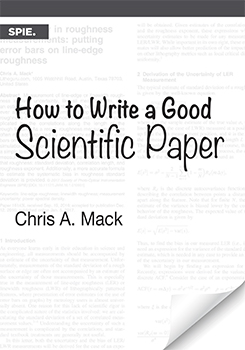
According to the William and Flora Hewlett Foundation, Open Educational Resources are "high-quality teaching, learning, and research materials that are free for people everywhere to use and repurpose."
According to UNESCO, Open Educational Resources (OERs) are any type of educational materials that are in the public domain or introduced with an open license. The nature of these open materials means that anyone can legally and freely copy, use, adapt, and re-share them. OER range from textbooks to curricula, syllabi, lecture notes, assignments, tests, projects, audio, video, and animation.
For more information on what is and is not OER see this short learning module from the Michigan chapter of the American Library Association. https://certificate.mioer.org/module-1/what-are-open-educational-resources
 Mack, CA, 2018. How to Write a Good Scientific Paper. Bellingham (WA): SPIE.
Mack, CA, 2018. How to Write a Good Scientific Paper. Bellingham (WA): SPIE.How to Write a Good Scientific Paper is a valuable resource for all students and faculty in science and engineering. SPIE is pleased to make it available here at no charge as a PDF eBook. As Dr. Mack explains, “Many scientists and engineers consider themselves poor writers or find the writing process difficult. The good news is that you do not have to be a talented writer to produce a good scientific paper, but you do have to be a careful writer. In particular, writing for a peer-reviewed scientific or engineering journal requires learning and executing a specific formula for presenting scientific work. This book is all about teaching the style and conventions of writing for a peer-reviewed scientific journal. From structure to style, titles to tables, abstracts to author lists, this book gives practical advice about the process of writing a paper and getting it published."
 Wettstein SG, 2022. Technical Writing and Simple Statistics: For Laboratory Courses. Bozeman (MT): Montana State University Library.
Wettstein SG, 2022. Technical Writing and Simple Statistics: For Laboratory Courses. Bozeman (MT): Montana State University Library.This upper division resource focuses on how to communicate results through technical writing, use Excel to perform simple statistics, and create professional charts/documents. Excel tutorials are provided for performing descriptive statistics, t-tests, and linear regression as well as using text boxes, formatting figures and captions, and using Equation Editor to insert equations. Additionally, guidance and examples of different communication components are provided along with team writing strategies and guidelines on how to hold efficient meetings.

